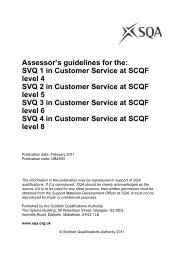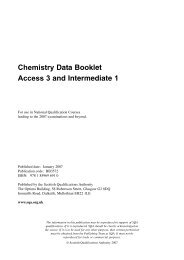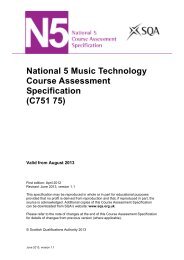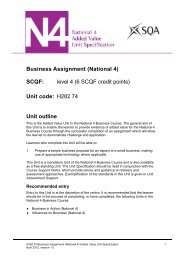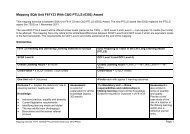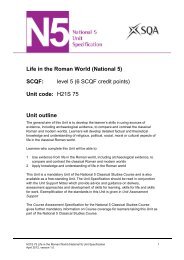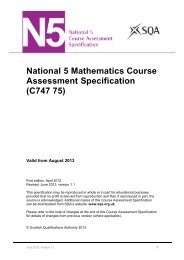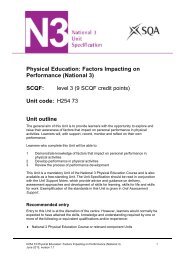Advanced Higher Biology Draft National Course Assessment ...
Advanced Higher Biology Draft National Course Assessment ...
Advanced Higher Biology Draft National Course Assessment ...
You also want an ePaper? Increase the reach of your titles
YUMPU automatically turns print PDFs into web optimized ePapers that Google loves.
voltage gated channels.<br />
(d) Detecting and amplifying an environmental stimulus.<br />
(i) Photoreceptor protein systems.<br />
Bacteriorhodopsin in archaea and photosynthetic pigments and ATP synthase.<br />
Photoreceptor retinal in animals and signal amplification in cone and rod cells<br />
and the role of opsins.<br />
(e) Communication within multicellular organisms.<br />
(i) Co-ordination.<br />
Extracellular signalling molecules, receptors and responses. Cell and tissue<br />
specific responses.<br />
(ii) Hydrophobic signals and control of transcription.<br />
Role of thyroid hormone and thyroxine on transcription of the gene for Na/K-<br />
ATPase in changing metabolic rate. Steroid hormones activate transcription.<br />
Hydrophilic signals and transduction, including peptide hormones and<br />
neurotransmitters. Binding of peptide hormones insulin and ADH to receptors<br />
and the cellular responses including GLUT4 and aquaporin 2. Diabetes type 1, 2<br />
and insipidus.<br />
(f) Protein control of cell division.<br />
(i) Cell division including structure, composition and role of the cytoskeleton,<br />
structure and role of microtubules.<br />
(ii) The cell cycle- G1, S and G2 phases of interphase. M phase and cytokinesis.<br />
The role of spindle fibres.<br />
(iii) Control and regulation of the cell cycle by checkpoints at G1, G2 and<br />
metaphase. G0 phase. The role of cyclins, kinases, cyclin-dependant kinases<br />
retinoblastoma and protein phosphorylation in the G1 checkpoint. The role of<br />
proteins including p53 in response to DNA damage resulting in DNA repair,<br />
arrests the cell cycle or cell death.<br />
(iv) Control of apoptosis. Role of lymphocytes and p53 in cell death.<br />
Unit 2 — Organisms and Evolution<br />
1 Field techniques for biologists<br />
(a) Health and safety.<br />
Hazards and risks associated with fieldwork.<br />
(b) Sampling wild organisms.<br />
Appropriate random, systematic and stratified sampling. Awareness of protected<br />
species in Scotland.<br />
(c) Identification and taxonomy.<br />
Methods of identification. The concept of taxonomic groupings. Classification of<br />
life into the three domains. Major divisions of the plant kingdom. The phyla of<br />
the animal kingdom.<br />
(d) Monitoring populations.<br />
The use of information on species abundance to assess environmental impact.<br />
Method of mark and recapture to estimate population size.<br />
Effective methods of marking.<br />
(e) Measuring and recording animal behaviour.<br />
Ethograms and time sampling to compare the behaviour of different individuals<br />
of a species.<br />
December 2012, draft version 1.0 9




